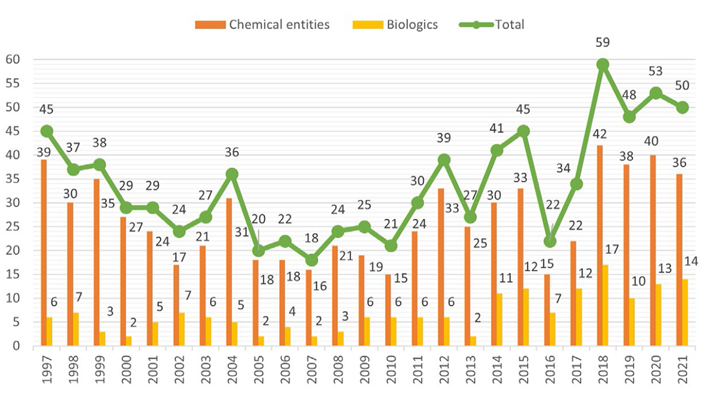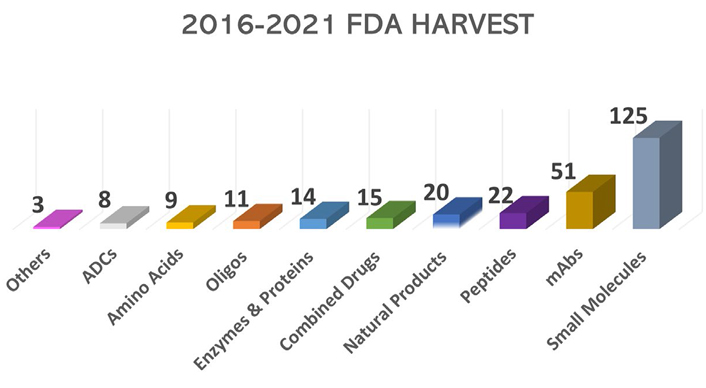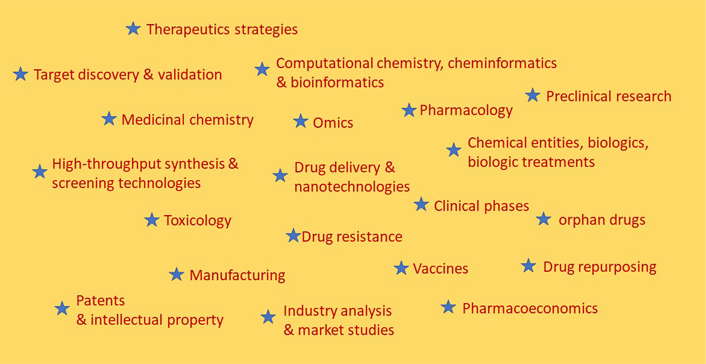One of the most exciting aspects of drug discovery is possibly the journey from coming up with an idea in the laboratory to getting the therapeutic agent into the market. This journey also has a major impact not only from the scientific perspective but also both socially and economically.
A new drug helps restore health and improves well-being, and may even save lives, but it requires many years of work (an average of 15 years) and a huge investment. The latest analyses estimate that the cost of bringing a drug to market has an average of approximately US $1.5–$2 billion, although some drugs have required an investment of even US $6 billion [1]. However, in contrast to what happens in other industrial fields, these enormous investments do not lead to a large number of new drugs reaching the market every year. Thus, for instance, the number of new drugs approved by the US Food and Drug Administration (FDA) each year has fluctuated in recent decades, with maxima of 59 new drugs in 2018, and 53 in both 1996 and 2020. Since 2014, this number has experienced a consolidated increase, with more than 40 drugs approved yearly, except in 2016 when only 22 were authorized (Figure 1) [2, 3].
The FDA’s Center for Drug Evaluation and Research (CDER) classifies these drugs as new molecular entities (NMEs) and biologics license applications (BLAs). NMEs, which include peptides and oligonucleotides, are mainly synthesized, including by chemical methods, and are fully characterized from a chemical perspective. In contrast, biologics [proteins, monoclonal antibodies (mAbs), and antibody-drug conjugates (ADCs)] are produced mainly by biotechnology. While the number of the so-called small molecules—NMEs of a molecular weight inferior to 600 of molecular weight—is fluctuant following the same trend as drugs, recent years have witnessed an important increase in the number of biologics approved. Thus, in the period 2016–2021, 59 mAbs (including 8 ADCs) were authorized, a figure that accounts for more than 20% of the total number of drugs authorized in that period (278 approved) (Figure 2) [4]. Given that this category also includes peptides and oligonucleotides, which although being NMEs show a great synthetic complexity, in that same period, 106 (40%) of the 278 drugs were challenging to produce [4]. This category does not include vaccines or gene therapies, which are approved by the FDA’s Center for Biologics Evaluation and Research (CBER).
By likening the drug discovery process to a car journey, we can appreciate several stages and these do not always involve traveling along straightforward highways but can become complicated due to the need to retrace the route, which very often leads back to the starting point.
There is a pre-discovery stage that seeks to identify compounds that have promising biological activity. According to analysts, some 5,000–10,000 compounds (Hit) from this stage enter what is formally known as the discovery phase. In this phase, various refinements of the chemical structures are made [structure-activity relationship (SAR)], which is known as Hit to Lead and allows 250–500 compounds to enter the preclinical phase. Here, in addition to final structural refinement (Lead to Candidate), toxicity and the form of administration, together with activity, are studied in animals. The pre-discovery and discovery phases can together take several years (4–8) [5].
Before entering clinical phases with humans, an Investigational New Drug (IND) application has to be submitted to the FDA or other pertinent medical agencies to gain authorization for the administration of the drug to humans. Of the 5,000–10,000 molecules that enter the discovery phase, only a single digit (< 10) will get through to Clinical Phase I (absence of toxicity) with a limited number of healthy humans. Next, Clinical Phase II, which involves a larger number of patients (hundreds), is undertaken to determine whether the drug works. For anticancer drugs, Clinical Phases I and II are combined and carried out on cancer patients. Finally, Clinical Phase III, which involves thousands of patients, seeks to determine whether the drug outperforms those already on the market, and also the final dosage and administration schedule. At the end of the clinical phases, which can take more years than the previous steps, a New Drug Application (NDA) is submitted to the FDA or other pertinent medical agencies to request final approval for the sale and marketing of the new product. On average, of the 5,000–10,000 molecules after pre-discovery, only one will reach the ultimate goal, namely the market [6, 7].
Therefore, the entire drug discovery process can take an average of 15 years and can cost US $1–$3 billion. The many years needed for the development of a drug, the high cost, and the expiration of patents mean that in 2021 only an average of 7% of new drugs achieve a return on investment (ROI), while in 2010 was 2.7% [8].
This whole scenario also has a significant impact on the final price of drugs. In an ideal world, medicine should be available to everyone and not to a select very small part of society. However, there is a huge risk of having different medicines for different sectors of the world’s population [9]. There are already several treatments with 6-digit price tags in US dollars and even three that costs 7 digits (being Zolgensma from Novartis Gene Therapies, Inc., the most expensive drug currently in the market with an annual cost of approximately US $2,125,000) and of course many costing 5 digits [10]. It is unlikely that these are covered mostly by public and private health systems. This type of reasoning must also be considered when talking about drug discovery.
This drug discovery journey involves the participation of a large number of professionals with different scientific backgrounds, including organic and computational chemists, cell and molecular biologists, geneticists, pharmacologists, toxicologists, veterinarians, medical doctors and nurses, epidemiologists, statisticians, ethics specialists, intellectual property specialists and lawyers, and business people, among others [11]. Although it is clear that omics (proteomics, genomics, metabolomics, etc.) are having a great impact on the current drug discovery process, economics is key and, regrettably, it drives some of the most important decisions in this context [12].
This challenging scenario of getting a drug onto the market serves to highlight the spectacular achievement of rolling out the first vaccinations against coronavirus disease 2019 (COVID-19) within a year of detecting the disease. Although medical agencies shortened some timeframes and approved these vaccines on the basis of Emergency Use Authorization (EUA) status, this rollout was possible because all the companies and public laboratories involved in the development of the vaccines had been working on similar ones for other types of targets for many years [13, 14]. The COVID-19 pandemic is showcasing the strength and solidity of the pharmaceutical ecosystem, which, in addition to big pharma, biotech, and start-up companies, also includes academic groups and hospitals, contract research and manufacturing organizations, and regulatory agencies. In this joint endeavor, all processes are followed meticulously, but in a public health emergency, such as that associated with COVID-19, the entire system is ready to react quickly and positively [13].
Although it could be thought that the drug discovery process ends once the drug has reached the market, this is not entirely true as there is still Clinical Phase IV [15]. This consists of post-release monitoring, of unlimited duration, where the side effects caused by the new drug over time are studied.
Exploration of Drug Science (EDS) is an open journal in all senses. EDS not only facilitates unrestricted access to knowledge from a lineal perspective but also looks for transversal and multifactorial strategies to pursue drug discovery from a fully holistic approach.
EDS came about with the idea of covering all the steps of this often magical process, from the pre-discovery, discovery, and preclinical phases to the clinical phases, manufacturing, intellectual property, and registration, with an important focus on financial aspects. The different topics covered by EDS are outlined in Figure 3.
As the founding Editor-in-Chief of EDS, I would like to invite colleagues to use our new platform to share their latest findings with the scientific community.
Abbreviations
| ADCs: | antibody-drug conjugates |
| COVID-19: | coronavirus disease 2019 |
| EDS: | Exploration of Drug Science |
| FDA: | Food and Drug Administration |
| mAbs: | monoclonal antibodies |
| NMEs: | new molecular entities |
Declarations
Author contributions
The author contributed solely to the work.
Conflicts of interest
The author declares that there are no conflicts of interest.
Ethical approval
Not applicable.
Consent to participate
Not applicable.
Consent to publication
Not applicable.
Availability of data and materials
Not applicable.
Funding
Not applicable.
Copyright
© The Author(s) 2023.


